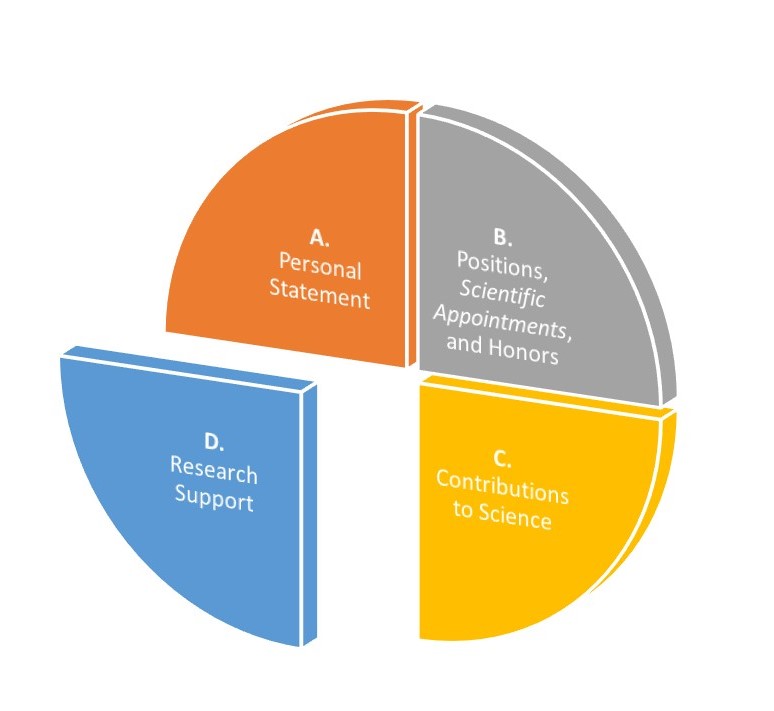For this week’s blog, I wanted to focus on a central component of any NIH grant — the biosketch. Did you know that the NIH is updating the biosketch format for all applications due on or after May 25th, 2021? Did you know that your application can get rejected if a biosketch in your grant application is formatted incorrectly? Regardless of where you are in your research career, if you are planning to apply for an NIH grant, it’s a great time to either get started on your biosketch or update what you have.

What is an NIH biosketch?
An NIH biographical sketch (or biosketch) is a five-page resume of your scientific work. A biosketch is required for all NIH grant applications and renewals. Like a resume, the goal of the biosketch is to communicate to the reviewers that you are the ideal person to undertake the research proposed. In its current form, the biosketch consists of four sections: (A) Personal Statement, (B) Positions and Honors, (C) Contributions to Science, and (D) Additional Information: Research Support or Scholastic Performance.
How to get started writing your NIH biosketch?
There are two major types of biosketches: Fellowship (for F-awards) and Non-Fellowship (for most other awards, including K-awards and R-awards). The NIH biosketch needs to be written in a specific format. The format varies a tiny bit between Fellowship and Non-Fellowship types, so first determine which kind of biosketch you want to prepare. There are two options to get started:
- Download the appropriate biosketch sample from the NIH Grants and Funding website and modify it as needed.
- Use the NIH SciENcv website (linked to your My NCBI account) to create your biosketch. I love this website and highly recommend giving this approach a try. The NIH SciENcv website is a joy to work with and incredibly simple to use. All you need to do is create a personal NIH bibliography, input all your information, and then export your biosketch as either a Word Document or PDF. The NIH SciENcv website automatically formats your citations and correctly inserts your data into the biosketch layout.
What are the major changes to the new biosketch?
For a complete list of changes, read more about the upcoming changes to the biographical sketch and other support format page in the NIH notice here: NOT-OD-21-073. As you will read, the changes are few but significant. I’ve highlighted a few of the major changes here in bolded italics.
- Section B has been renamed. Instead of “Positions and Honors” it is now “Positions, Scientific Appointments, and Honors.” In this section you now need to include both domestic and foreign positions and scientific appointments. The NIH is asking that individuals now list any affiliations with foreign entities or governments. If this applies to you, definitely read through this section carefully as titles can include full-time, part-time, or even voluntary positions.
- In Section B, the “Positions, Scientific Appointments, and Honors” should now be listed in reverse chronological order. In the past, these materials were listed in chronological order.
- For non-Fellowship biosketches, Section D (Additional Information: Research Support) has been removed. In its place, details about ongoing and completed research projects from the past three years should be included in Section A (Personal Statement).
What are the major changes to the “Other Support” section?
While the changes to the NIH biosketch are minimal, in the same notice (NOT-OD-21-073) the NIH will now require more documentation for the “Other Support” section of your grant. These changes include:
- Inclusion of all resources, including in-kind contributions (i.e. office/laboratory space, equipment, supplies, or researchers supported by an outside source).
- Addition of a signature block (for the Principal Investigator and Other Senior/Key Personnel) to certify the accuracy of the information.
“The views, opinions and positions expressed within this blog are those of the author(s) alone and do not represent those of the American Heart Association. The accuracy, completeness and validity of any statements made within this article are not guaranteed. We accept no liability for any errors, omissions or representations. The copyright of this content belongs to the author and any liability with regards to infringement of intellectual property rights remains with them. The Early Career Voice blog is not intended to provide medical advice or treatment. Only your healthcare provider can provide that. The American Heart Association recommends that you consult your healthcare provider regarding your personal health matters. If you think you are having a heart attack, stroke or another emergency, please call 911 immediately.”